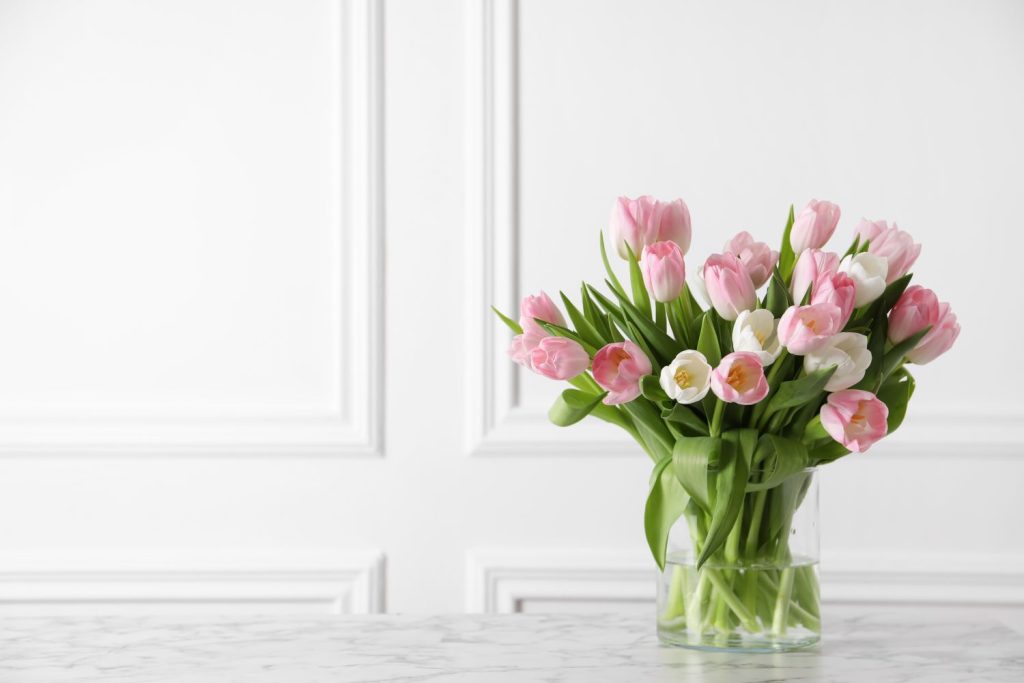Tulips, with their vibrant colors and elegant form, are a quintessential symbol of spring. Bringing a bouquet of these beauties into your home instantly brightens the atmosphere. But to ensure your tulips thrive indoors, proper vasing is key. This guide will walk you through every step, from selecting the freshest blooms to keeping them looking their best for days to come.

Choosing the Perfect Tulips:
The journey to a stunning vase arrangement starts at the flower shop. Here’s how to pick the best tulips:
- Bud Tightness: Opt for tulips with closed buds that show a hint of their color. These will gradually open indoors, extending your enjoyment. Avoid blooms that are fully unfurled or have loose, drooping petals.
- Stem Strength: Select tulips with firm, straight stems. Bendy or bruised stems might struggle to hold the blooms upright.
- Color Harmony: Tulips come in a breathtaking range of colors. Choose a single, bold hue for a striking statement, or create a vibrant mix for a playful display. Consider the color scheme of your room when making your selection.

Preparing the Tulips for the Vase:
Once you have your perfect tulips, it’s time to prepare them for their indoor debut:
- Gather Supplies: You’ll need a clean vase, sharp shears or pruners, and lukewarm water. A commercial flower food packet (optional) can further enhance vase life.
- Clean the Vase: A clean vase prevents bacterial growth that can shorten the lifespan of your flowers. Wash the vase thoroughly with warm, soapy water and rinse well before use.
- Cut the Stems: Using your sharp shears, cut about 1-2 inches off the bottom of each stem at a 45-degree angle. This angled cut increases the surface area for water absorption. Avoid using a blunt tool that could crush the stems.
- Remove Lower Leaves: Any leaves that will fall below the water line in the vase should be removed. Submerged leaves can decompose and foul the water.
Creating a Stunning Arrangement:
With your tulips prepped, it’s time to design your arrangement:
- Fill the Vase: Fill your clean vase about one-third full with lukewarm water. Cooler water is preferred over hot water for most cut flowers.
- Flower Food (Optional): If using commercial flower food, follow the package instructions for mixing it with the water. Flower food provides essential nutrients and helps regulate water pH, promoting longer life for your blooms.
- Arranging the Tulips: Start by placing a single tulip in the center of the vase. Hold the stem firmly and adjust its position to achieve your desired height. Then, add additional tulips one at a time, arranging them in a balanced way. You can create a tight cluster or a more spread-out display, depending on your preference.

Top Tips for Long-Lasting Tulips:
Here are some additional secrets to ensure your tulips continue to thrive in their vase:
- Location, Location, Location: Keep your tulips away from direct sunlight and drafts. Both can cause the blooms to wilt prematurely. A cool, well-ventilated spot is ideal.
- Daily Refresh: Every day or two, re-cut the stems at an angle and replace the water in the vase. This prevents bacteria growth and keeps the water fresh.
- Sugar and Bleach Trick (Optional): In a pinch, you can create a homemade substitute for flower food. Mix one teaspoon of sugar and two drops of chlorine bleach (not scented) per gallon of water. The sugar provides nourishment, while the bleach acts as a mild disinfectant.
Beyond the Basics: Creative Tulip Arrangements:
While a simple vase filled with tulips is undeniably beautiful, you can explore various creative options:
- Mix and Match: Combine tulips with other spring blooms like daffodils or hyacinths for a more textural and colorful display.
- Greenery Accents: Add a touch of greenery by incorporating eucalyptus branches or other leafy greens into your arrangement.
- Container Choices: Think beyond traditional vases. Use a vintage pitcher, a mason jar, or even a watering can for a unique touch. Just ensure the container is clean and watertight.

Displaying the vase
Once you’ve created your stunning arrangement, finding the ideal location for your tulip vase is key to maximizing their lifespan and visual impact. Here are some factors to consider:
Light:
- Avoid Direct Sunlight: While tulips appreciate some indirect sunlight, direct sun exposure can cause the blooms to wilt prematurely and fade.
- Bright, Indirect Light: A spot with bright, indirect light is ideal. North-facing windows are perfect for this purpose.
Temperature:
- Cool and Draft-Free: Keep your tulips away from heat sources like vents and radiators. Drafts can also dehydrate blooms, so avoid placing them near frequently opened doors or windows.
- Moderate Temperatures: A cool room with moderate temperatures (around 60-68°F) is best.
Aesthetics:
- Focal Point: Position your vase where it can be admired. Coffee tables, sideboards, or entryway consoles are common choices.
- Complementary Colors: Consider the colors in your arrangement and choose a backdrop that complements them. A light-colored background allows vibrant blooms to stand out, while a darker background can create a dramatic effect.
Additional Tips:
- Grouping Arrangements: For a more impactful display, group several tulip vases of different sizes or colors together.
- Varying Heights: If using multiple vases, arrange them at varying heights for a more dynamic look.
By following these tips, you can showcase your beautiful tulip creations in a way that enhances your home’s décor and allows you to enjoy their spring beauty for days to come.
Avoiding direct sunlight and excessive heat
Absolutely, avoiding direct sunlight and excessive heat is crucial for many reasons. Here’s a breakdown of the key points:
Sun Damage:
- Skin: Direct sunlight exposes you to ultraviolet (UV) rays, which can cause sunburn, premature aging, and increase the risk of skin cancer.
- Plants: While plants need sunlight for photosynthesis, too much direct sun can scorch leaves and dry them out.
Heat-Related Issues:
- Dehydration: Excessive heat accelerates sweat production, leading to dehydration if fluids aren’t replenished.
- Heatstroke: In extreme cases, prolonged exposure to high temperatures can cause heatstroke, a serious medical condition.
Preventive Measures:
- Seek Shade: When outdoors during peak sun hours (typically 10 am to 4 pm), find shade whenever possible. Trees, umbrellas, or awnings offer good protection.
- Protective Clothing: Wear lightweight, loose-fitting clothing made from breathable fabrics like cotton or linen. Hats with wide brims shield your face and neck from the sun.
- Hydration: Drink plenty of water throughout the day, even if you don’t feel thirsty. Avoid sugary drinks that can dehydrate you further.
- Air Conditioning: If indoors, use air conditioning or fans to maintain a comfortable temperature.
By following these tips, you can enjoy the outdoors safely and keep your plants thriving.

With a little planning and these simple steps, you can transform your tulips into a captivating centerpiece that will grace your home for days to come. So, the next time spring arrives, embrace the vibrant energy of tulips by bringing them indoors and showcasing their elegance in a stunning vase arrangement.


